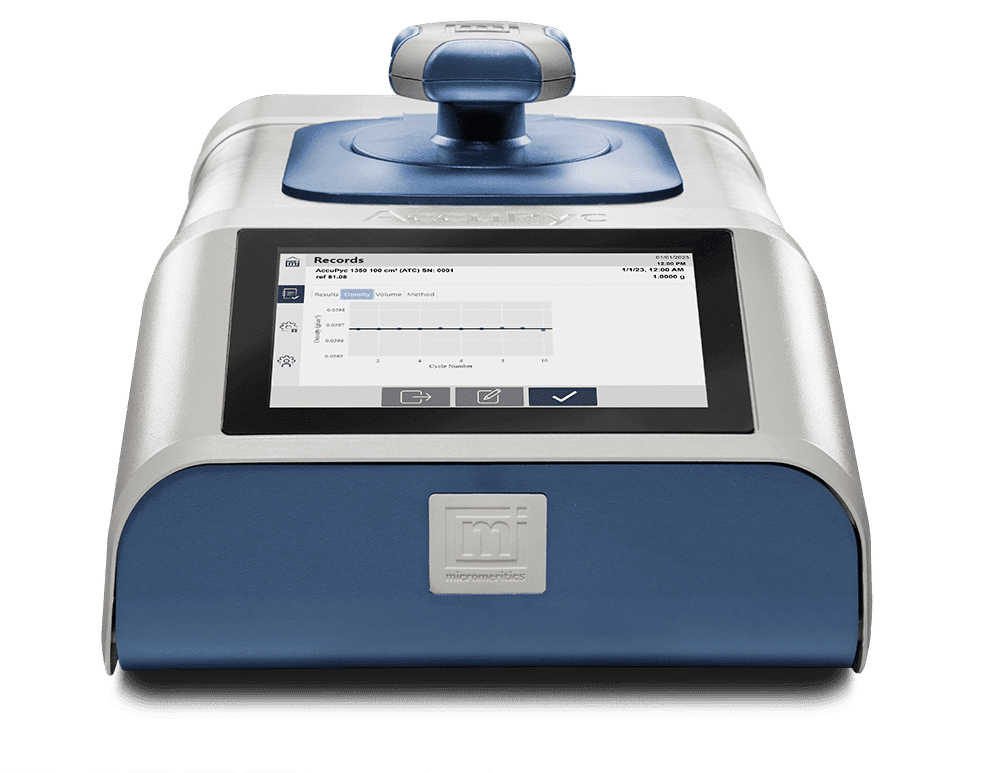AccuPyc III 1350 Gas Pycnometer
The fastest, easiest, most accurate measurement of true density
The AccuPyc gas pycnometer from Micromeritics is trusted around the
world to provide the most reliable measurements of true density. More
labs choose an AccuPyc than any other commercial gas pycnometer.
The AccuPyc delivers the highest available accuracy and repeatability
in a system that is fast and easy for any operator to use.

Gas displacement pycnometry
Gas pycnometry is used to determine the true, or skeletal density of solid materials and slurries. A sample is placed in a chamber of known volume, which is sealed and pressurized. The gas fills the empty spaces within and between the sample particles. The sample chamber is then expanded to an adjoining reference chamber of known volume. The change in pressure is used to calculate the volume of the sample. True density is calculated from the sample mass and the volume it occupies. This method is useful for determining the true density of materials, even those with small pores and irregular shapes.
Defining density
The AccuPyc provides an accurate determination of the True (Absolute) Density by gas pycnometry. This is important for porous and particulate materials because it excludes empty spaces associated with pores and interparticle voids. For materials with closed pores, those pores are included in the volume measurement and the density reported is a Skeletal (Apparent) Density.
The GeoPyc is a helpful complement to the AccuPyc as it directly measures the: Bulk Density, the Envelope Density including pores, and the T.A.P. density incorporating consolidation stresses. Bulk and envelope density measurements from the GeoPyc can be used with true density from the AccuPyc to report pore volume and porosity.
- Active temperature control
- Hinged, self-aligning lid
- PowderSafe mode
- MIC NET data and method synchronization
- Manged method library
- WiFi Connectivity and 3 USB ports
- USB Balance integration
- Vacuum and pulse sample preparation
- FoamPyc methods
- NIST-Traceable volume reference
| Cell Volume | ||
|---|---|---|
| Nominal | 10 cm3 | 100 cm3 |
| Available Inserts | 0.1cm3, 1cm3, 3.5cm3 | 3.5cm3, 10cm3, 35cm3 |
| Specifications | ||
|---|---|---|
| Temperature | TS: 20 °C ± 0.025 °C ATC: 4 °C to 60 °C ± 0.025 °C | |
| Volume Accuracy | 0.02% | |
| Volume Repeatability | 0.01% | |
| W x D | 26.5 cm x 43.0 cm | |
Selected International Test Standards
| ASTM B923 | Metal Powders |
| ASTM C110 | Cement |
| ASTM C604 | Refractory Materials |
| ASTM C799 | Nuclear Materials |
| ASTM D2638 | Carbon |
| ASTM D2856 | Foam |
| ASTM D4892 | Petroleum |
| ASTM D5550 | Soil |
| ASTM D5965 | Coatings |
| ASTM D6093 | Coatings |
| ASTM D6226 | Foam |
| ASTM D6761 | Catalysts |
| ASTM D70 | Asphalt |
| ASTM D8171 | Fibers |
| DIN 66137 | Pycnometry |
| ISO 12154 | Pycnometry |
| ISO 18753 | Ceramics |
| ISO 4590 | Foam |
| ISO 8130 | Coatings |
| USP <699> | Pharmaceuticals |
The FoamPyc methods follow ASTM and ISO methodologies to determine open and closed cell content, compressibility and cell fracture with chemically and mechanically formed cellular polymers such as PVC, polystyrene and polyurethane.
